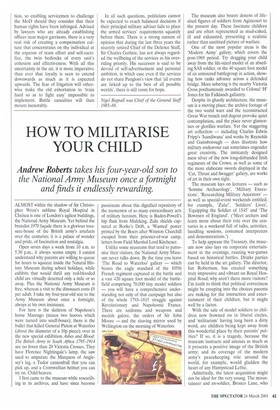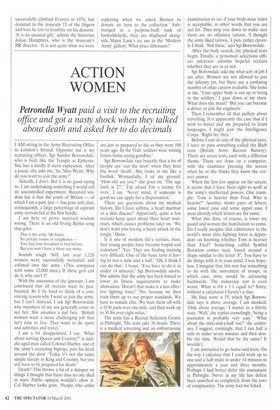HOW TO MILITARISE YOUR CHILD
Andrew Roberts takes his four-year-old son to
the National Army Museum once a fortnight and finds it endlessly rewarding.
ALMOST within the shadow of Sir Christopher Wren's sublime Royal Hospital in Chelsea is one of London's ugliest buildings, the National Army Museum. Yet behind the brutalist 1970 façade there is a glorious treasure-house of the British army's artefacts over the centuries; it is a palace of wonder and pride, of fascination and nostalgia.
Open seven days a week from 10 a.m. to 5.30 p.m., it always seems empty. I cannot understand why parents are willing to queue for hours to squeeze inside the Natural History Museum during school holidays, while exhibits that would thrill any red-blooded child are virtually deserted only a mile or so away. Plus the National Army Museum is free, whereas a visit to the dinosaurs costs £9 per adult. I take my four-year-old son to the Army Museum about once a fortnight, always at his own insistence.
For here is the skeleton of Napoleon's horse Marengo (minus two hooves which were turned into snuff-boxes); there is the bullet that killed General Picton at Waterloo (about the diameter of a 10p piece); over in the new special exhibition Ashes and Blood: The British Army in South Africa 1795-1914 are no fewer than 20 Victoria Crosses. They have Florence Nightingale's lamp, the saw used to amputate the Marquess of Anglesey's leg, a Tudor cannonball that you can pick up, and a Cromwellian helmet you can try on. Child heaven.
I first came to the museum while reseaiehing in its archives, and have since become passionate about this dignified repository of the mementos of so many extraordinary acts of military heroism. Here is Baden-Powell's hip flask from Mafelcing, Zulu shields captured at Rorke's Drift, a 'Wanted' poster printed by the Boers after Winston Churchill escaped from their prisoner-of-war camp, letters from Field Marshal Lord Kitchener.
Unlike some museums that tend to patronise their visitors, the National Army Museum never talks down. By the time you leave The Road to Waterloo' gallery — which boasts the eagle standard of the 105th French regiment captured at the battle and a vast 420 square foot model of the battlefield comprising 70,000 tiny model soldiers — you will have a comprehensive understanding not only of that campaign but also of the whole 1793-1815 struggle against Revolutionary and Napoleonic France. There are uniforms and weapons and medals galore, the orders of Sir John Moore — and the shaving mirror used by Wellington on the morning of Waterloo. The museum also boasts dozens of lifesized figures of soldiers from Agincourt to the present day. These fascinate children and are often represented as mud-caked, ill and exhausted, presenting a realistic rather than sanitised picture of warfare.
One of the most popular areas is the 'Modern Army' gallery, which covers the post-1969 period. Try dragging your child away from the life-sized model of an abseil= ing SAS soldier, or the 40 square foot model of an armoured battlegroup in action, showing how tanks advance across a defended bridge. More sobering is the nearby Victoria Cross posthumously awarded to Colonel 'H' Jones for his Falklands gallantry.
Despite its ghastly architecture, the museum is a moving place; the archive footage of the two world wars and the reconstructed Great War trench and dugout provoke quiet contemplation, and the place never glamorises or glorifies warfare. Yet the staggering art collection — including Charles Edwin Fripp's Isandlwana' and works by Reynolds and Gainsborough — does illustrate how military endeavour can sometimes engender great creativity. The intricately designed mess silver of the now long-disbanded Irish regiments of the Crown, as well as some of the more elaborate swords displayed in the 'Cut, Thrust and Swagger' gallery, are works of art in their own right.
The museum lays on lectures — such as 'Somme Archaeology', 'Military Executions', 'Researching Military Ancestors' — as well as special-event weekends entitled, for example, 'Zulu!'. 'Soldiers' Lives', 'Equipping the Soldier of 1545' and 'The Bowmen of England'. ('Meet archers and learn more about their role over the centuries in a weekend full of talks, activities, handling sessions, costumed interpreters and demonstrations.') To help appease the Treasury, the museum now also lays on corporate entertainment in the evenings, running war-games based on historical battles. Drinks parties can be held in the art gallery. The director, Ian Robertson, has created something truly impressive and vibrant on Royal Hospital Road; why aren't there more visitors? I'm loath to think that political correctness might be creeping into the choices parents are making for the instruction and entertainment of their children, but it might well be a factor.
With the sale of model soldiers to children now frowned on in liberal circles, and 'militarism' having long been a dirty word, are children being kept away from this wonderful place by their parents' politics? If so, it is a tragedy, because the museum instructs and amuses as much as it presents a positive image of the British army; and its coverage of the modern army's peacekeeping role around the world, for example, would gladden the heart of any Hampstead Leftie.
Admittedly, the latest acquisition might not be ideal for the very young. The mountaineer and ex-soldier, Bronco Lane, who
successfully climbed Everest in 1976, has donated to the museum 15 of the fingers and toes he lost to frostbite on his descent. 'It is an unusual gift,' admits the historian Julian Humphrys, who is the museum's PR director. 'It is not quite what we were
expecting when we asked Bronco to donate an item to the collection.' Submerged in a purpose-built tank of formaldehyde, they are displayed alongside Major Lane's ice axe in the 'Modern Army' gallery. What price dinosaurs?















































































 Previous page
Previous page